Good wind and tide predictions are key to successful inshore fishing. This guide explains why Windfinder is an excellent app to that end.
You've probably heard me say it before: prior, proper planning prevents poor performance. It's an old axiom from the time of Bulk Fuel that rings true when fishing Louisiana's coast for speckled trout and redfish.
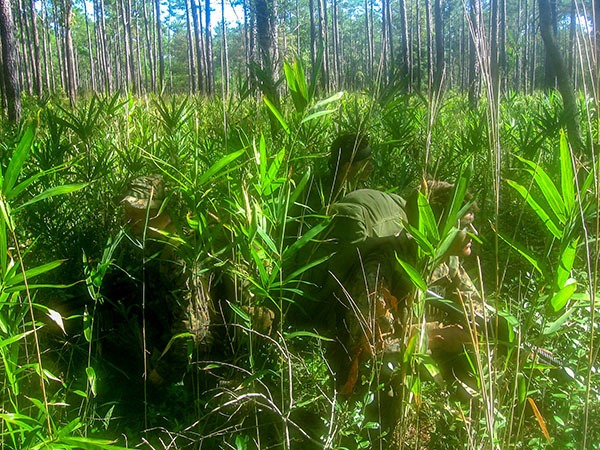
Bulk Fuel teams plan their patrols down to painstaking detail to ensure mission success. This applies just the same to our inshore fishing trips.
Fail to plan, and you plan to fail. That's another one.
If it's not clear, I am really big on planning my fishing trips so I know where to go and what to do once I get there.
Is Windfinder good for inshore fishing in Louisiana?
It is critically important to know what the conditions are going to be like the day of your fishing trip. Things like wind, weather and tide.
Imagine launching your boat without having planned for these items, what would your day be like? It certainly wouldn't go as well as if you had taken a look at the predicted conditions. It could even end in disaster, not unlike what happened to me on this trip to Venice (where I had not done my navigational homework).
This is why I take fishing trip planning so seriously, and use a multitude of resources to paint the picture as to what is going on in the marsh so I can make the best decision as where to go and what to fish for.
I will tell you that the most important condition to plan for is wind. It determines where and how you can fish, which bodies of water you can cross and which bodies are off-limits.
My favorite resource for wind prediction is Windfinder. I've been using it since 2015 and it has been pretty good to me. I'd say that "yes", this is an excellent tool for inshore anglers like yourself.
Keep reading, and you'll see that this resource does more than just detail the wind. It does a pretty good job on wave height, wave period, precipitation and tide, too.
What is Windfinder?
Windfinder is a resource — available on its website or smartphone app — that helps us measure current conditions and get an idea as to what those will be like in the coming days. The name is obvious, I guess.
Anyway, it is — interestingly — not a fishing centric app. It doesn't appear to be geared for fishing at all. I can't find the term "fishing" anywhere on their site outside of place names.
In fact, if you go to their About Us page (which does have mildly interesting history as to how they got started in Germany) they describe their product as having roots in competitive sailing.
Then they describe their modern product as being "for kitesurfers, windsurfers, surfers, sailors, paragliders and everyone waiting for the perfect breeze."
Which is funny, because more often than not we inshore anglers can totally do without that "perfect breeze", especially when crossing large bodies of water like we do during the summer. Ha ha!
Windfinder is something of a wonderful accident for inshore fishing. We do utilize the water (albeit in a different way) as the aforementioned sailors and surfers do, so a tool designed for them ultimately works very well for us.
So, what makes this app so good in the first place? Let's dive into that.
What makes Windfinder so good?
Windfinder accurately predicts the conditions relevant to planning an inshore fishing trip, and does so to a greater precision than what we've typically used in the past.
These reasons explain why:
Plenty of Weather Stations
There's no shortage of weather stations available to inshore anglers. No matter where you fish, there's a weather station — if not two, three or more — available for your perusal.
This is good, because when I am planning a fishing trip to a particular area it's good to judge the predicted conditions on each side in order to paint a better picture as to what will actually happen the day of my fishing trip.
A Good Example
This is best explained with an example, and a good personal example from myself would be my planning a fishing trip to the East Biloxi Marsh between Mississippi and Chandeleur Sounds, like where I caught speckled trout in this YouTube video.
See, I live in the Slidell area, which means the shortest way to get to the East Biloxi Marsh would be to launch from Slidell (Rigolets Marina being a good choice) or somewhere on the Mississippi Coast.
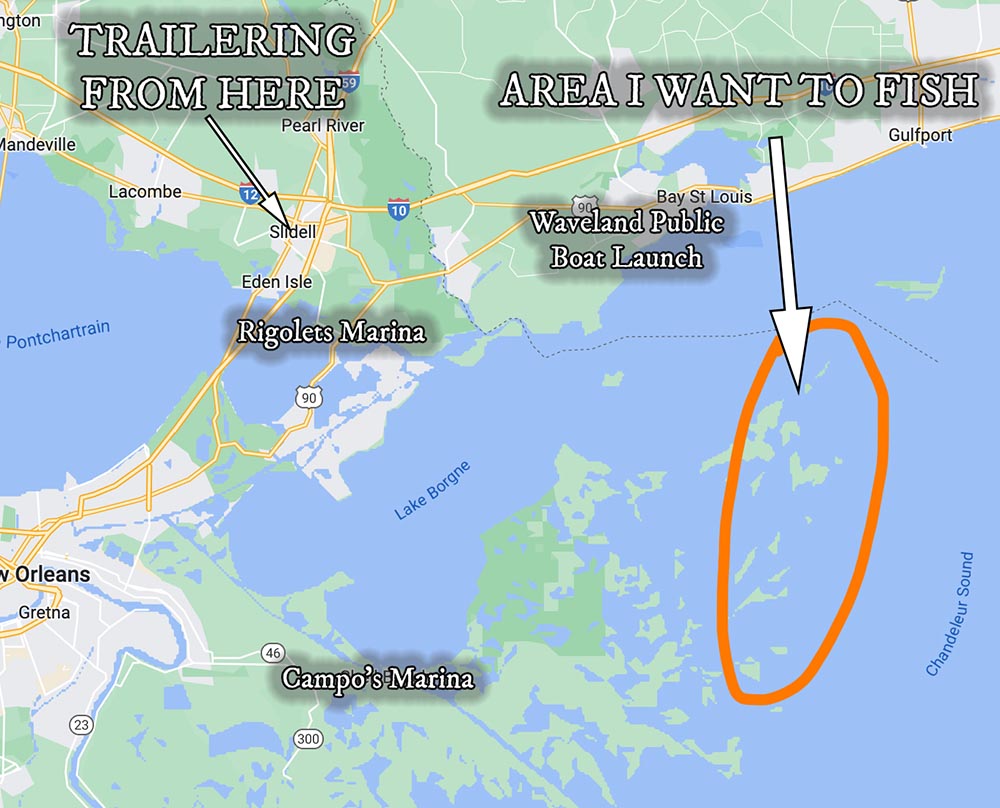
Regardless of which choice is made, crossing large bodies of water to get to the final destination is inevitable. The wind must cooperate or there could be an unnecessarily rough ride or — worse yet — a potentially dangerous situation that could end badly.
So, if you look at Louisiana's coast on Windfinder, you will see that there are several stations bordering the area I want to fish:
- Lake Pontchartrain/Rigolets
- Silver Slipper Casino
- Mississippi Sound/Grand Pass
- Old Shell Beach
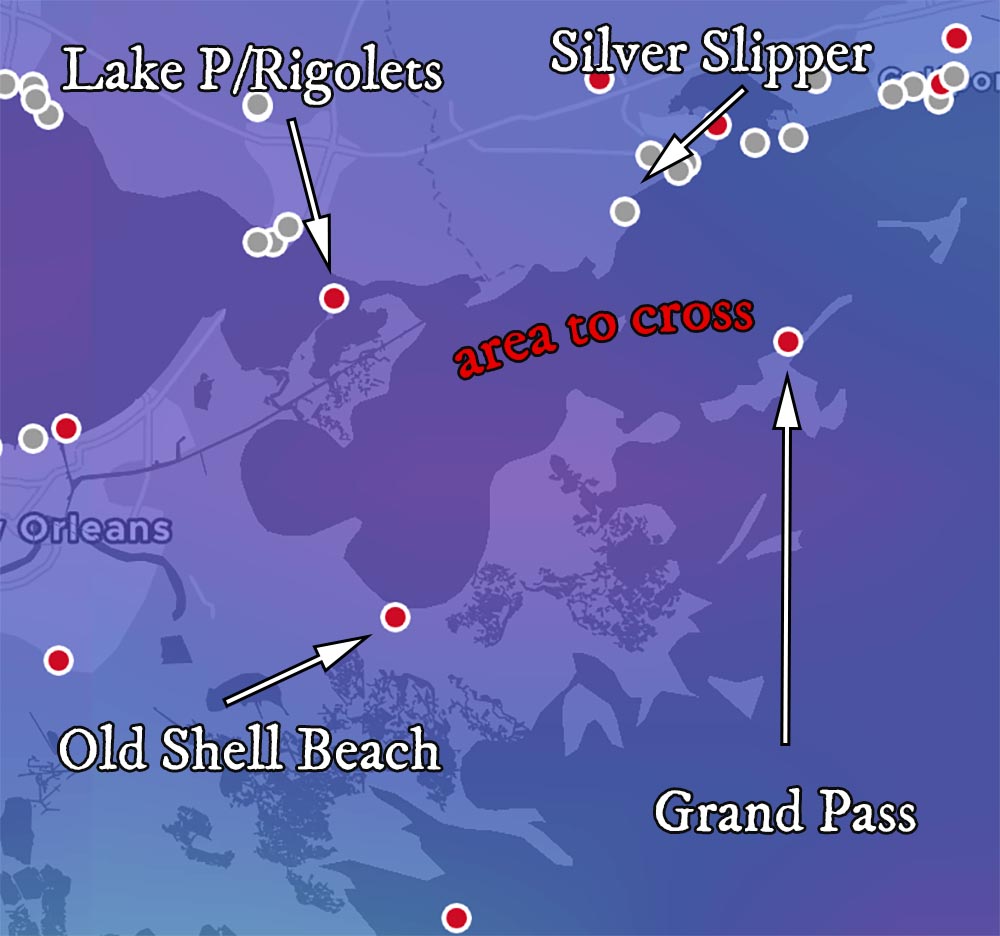
There are others, but these are the ones I use to get a handle on how smooth (or rough) my ride across Lake Borgne or Mississippi Sound will be.
If it appears the wind won't cooperate, then I'll have to trailer to Shell Beach and run protected through the marsh (which is a long ride in both the truck and boat), or change my plans to fish somewhere else (Plan Redfish is a good example).
Anyway, the point here is that there's not just a few stations for us to use, there are dozens across Louisiana's coast.
Windfinder Predicts All The Relevant Conditions (well...mostly)
There are five conditions I am concerned with when planning a fishing trip:
- wind speed/direction
- cloud cover
- precipitation
- wave height/period
- tide tables
Now, when you look at a Windfinder weather station, it is obvious there are more conditions than those listed above. That's fine.
I'm not super concerned with air pressure or air temperature when it comes to planning a fishing trip. I subscribe to Buck Perry's theory on light conditions over barometric pressure, so I suggest checking that out before writing me any hate mail. Ha ha!
Now, there are other conditions I like to look at (i.e. river height) that are not included by Windfinder, so that is detailed later in this guide.
For now, it's important to know that Windfinder gets the "meat and potatoes" of fishing conditions correct, and more accurately than what we are accustomed to, which leads me to my next point:
Windfinder Is More Precise
In years past — long before the advent of smart phones and the near-ubiquitous data signal along Louisiana's coast — inshore anglers relied upon the National Oceanic and Atmospheric Administration's (NOAA) Marine Forecast.
My father recounts calling a phone number that played a recording of the daily marine forecast. That was sometime back in the '90s.
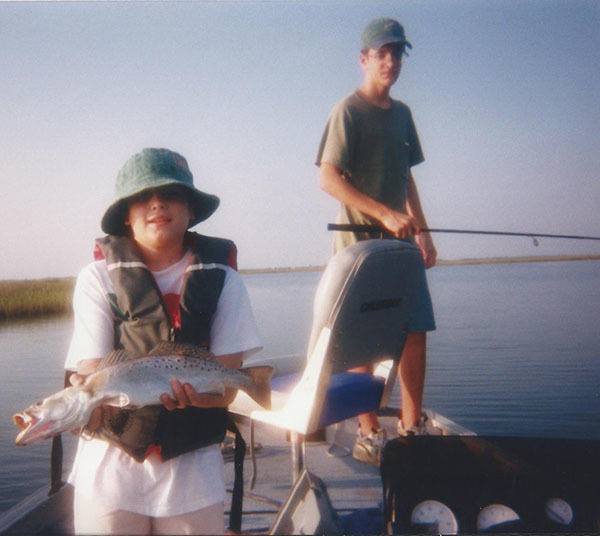
Biloxi Marsh sometime in the 1990s. The information amenities we enjoy today did not exist back then. My brother shows off a nice speckled trout, I look on forlornly.
Today, NOAA has a website we can refer to and I still use it to get an idea as to what is predicted to happen the day of my fishing trip.
If you take a look at it, you'll see that they don't have the same number of weather stations as Windfinder does, instead they give a forecast for a general zone.
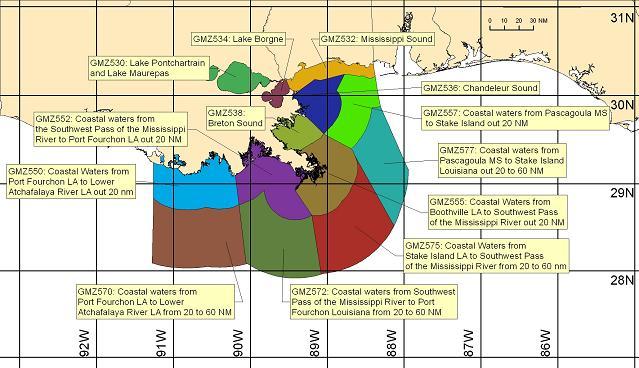
NOAA's Marine Forecast is offered for general areas, rather than specific stations.
And the forecast for that zone is only for a 24 hour period, or a day forecast and a night forecast (so, a 12 hour period).
That pales in comparison to the 3-hour forecast Windfinder boasts, not to mention the superior number of weather stations.
That and the NOAA Marine Forecast doesn't include as much information.
So why do I still use the NOAA Marine Forecast?
I like the synopsis explaining what's going on, and I also look for agreement between it and Windfinder. This is especially important for fishing areas sensitive to wind, such as large bodies of water.
What's also advantageous of Windfinder is that it shows if the wind will lay down during one part of the day. The NOAA Marine Forecast simply isn't that precise.
If there's a window the wind lays down, I sure would like to know about it. For example, that could be my window to fish mid-lake in Lake Pontchartrain, or run crab traps for triple tail in Mississippi Sound.
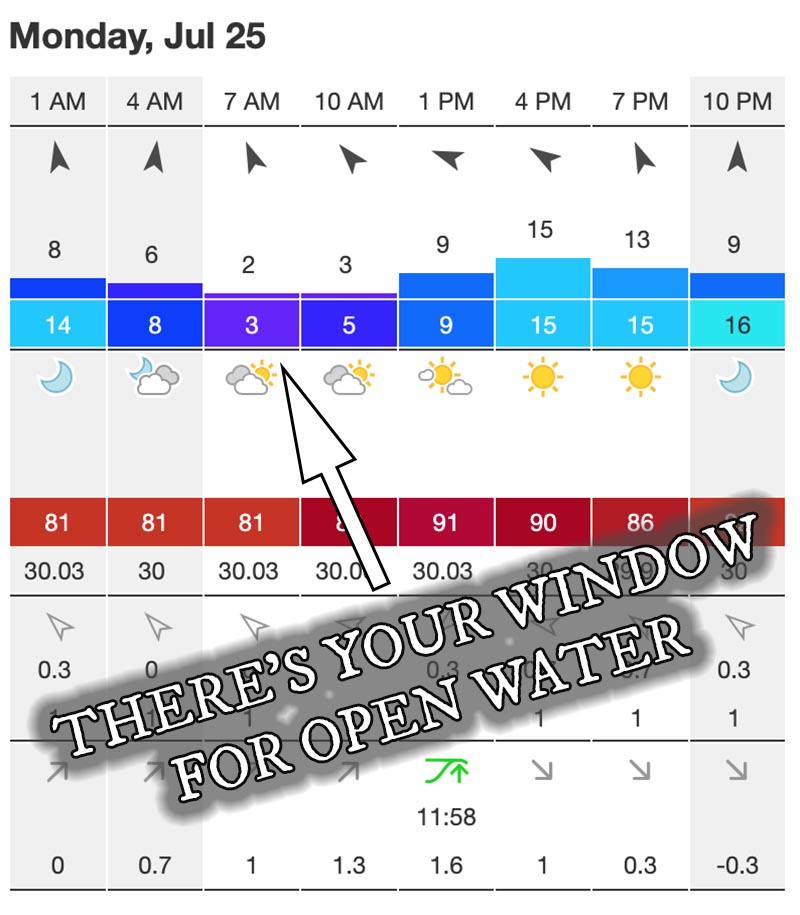
There is nothing more irritating than not going fishing because of a strong wind forecast, then seeing the wind was calm half the day before kicking up.
This 3-hour wind prediction becomes mighty helpful if you're looking for a quick trip before or after work.
Their Graphical Wind Map Reveals More Than Text Forecasts Do
Windfinder boasts a cool map that details wind speed and direction using color-coded graphical arrows.
It reveals that wind does not move uniformly across Louisiana's coast. Wind can be going one way on one side of a large body of water and the other direction on the opposite side.
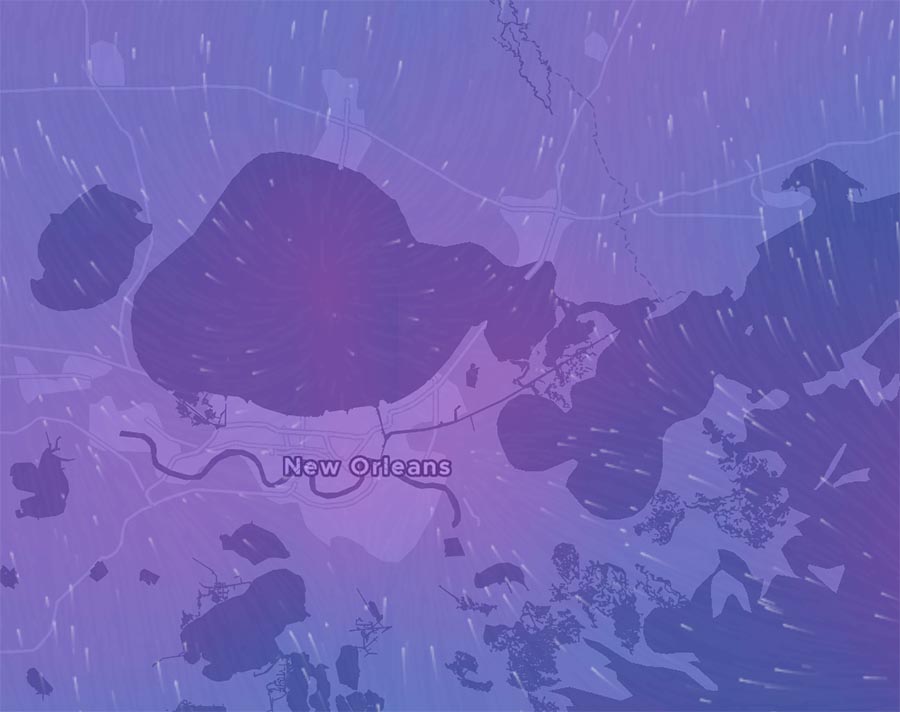
The Wind Speed Particles feature clearly shows that wind is blowing in opposite directions on opposite sides of Lake Pontchartrain.
This is a picture that mere text-based forecasts have difficult painting, and lends to a better understanding of the marsh for inshore anglers.
How To Use Windfinder For Inshore Fishing
So, how do we use Windfinder for inshore fishing? That's a good question worth exploring, but I have to preface the answer with a couple things:
- I cover this ad nauseum in Fishing Trip Planning Resources on LAFB Elite
- The "planning" section of Inshore Fishing 101 looks at this in-depth
- My seasonal courses like Summer Fish Location really hammer this home, too
- We help eachother plan fishing trip inside the LAFB Elite Community
However, you are here — and I appreciate that — so let's gloss over what to look for in a wind forecast when planning a fishing trip:
As mentioned earlier, wind is the biggest factor, I apply its predicted speed and direction to the area I want to fish in order to see how it affects that area and how to get there.
How Wind Affects Your Fishing Spots
You generally want to be protected from the wind, in the "lee of the land". The harder the wind blows, the more protected you want to be.
When I say "protected" I mean placing your boat somewhere the water isn't being directly affected by the wind.
The Great Wall of Chalmette is a good example (and a good fishing spot), so let's use that. For your reference, it is found here: 29.996 N 89.905 W
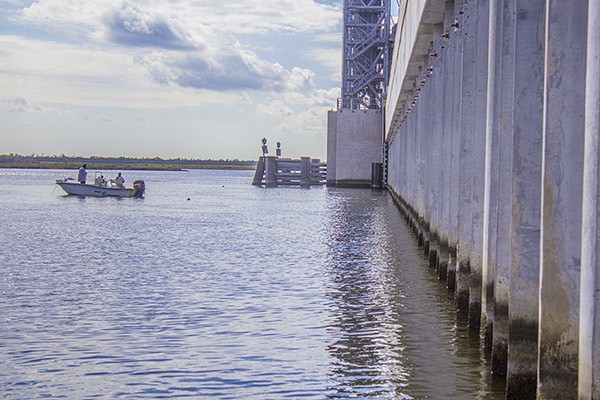
The Great Wall of Chalmette has become a classic fishing spot for winter speckled trout.
See, if the wind were blowing 25 knots out of the southeast, fishing The Wall would be a nightmare, even dangerous. Your boat would be bouncing all over the place and could very well be swamped by a large wave.
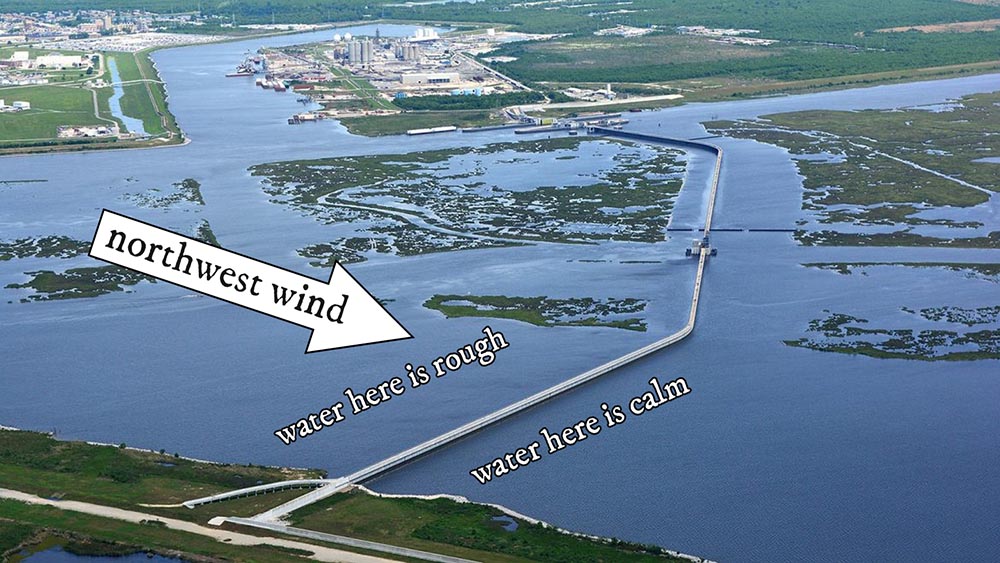
However, if the wind were blowing from the opposite direction — 25 knots from the northwest — then you won't have this problem. In fact, you'd be sitting pretty in calm water, as The Wall literally blocks the wind from blowing on the water's surface.
But, only up to a point. If you get far enough away from The Wall the wind will have enough "runway" to generate poor conditions.
It's a "No Brainer"
Because The Wall blocks a northwest wind so well, it is able to protect that water from harsh cold fronts, and it should come as no surprise that this area is such a productive fishing spot during winter.
Wind also has an effect on tide. Depending on its velocity and strength, it has the power to radically effect the predicted tide:
- tide could be delayed or hastened by wind
- wind can completely cancel the tide or make it stronger
That and a strong wind can make water very dirty, which is typically bad for fishing.
For more on how wind affects the tide I suggest checking out this blog post or — if you'd like to go more in-depth — enrolling in my course Mastering The Tide.
Navigational Considerations
This one is pretty easy:
- the stronger the wind, the more inaccessible large bodies of water become
- lighter wind = more liberty you have in running your boat
Easy Example
If the wind is predicted at 15-20 knots from the north the day of your fishing trip to Dularge, then running down the middle of Lake De Cade may not be the best idea.
The south shoreline would be the worst route and the north shoreline would be the best.
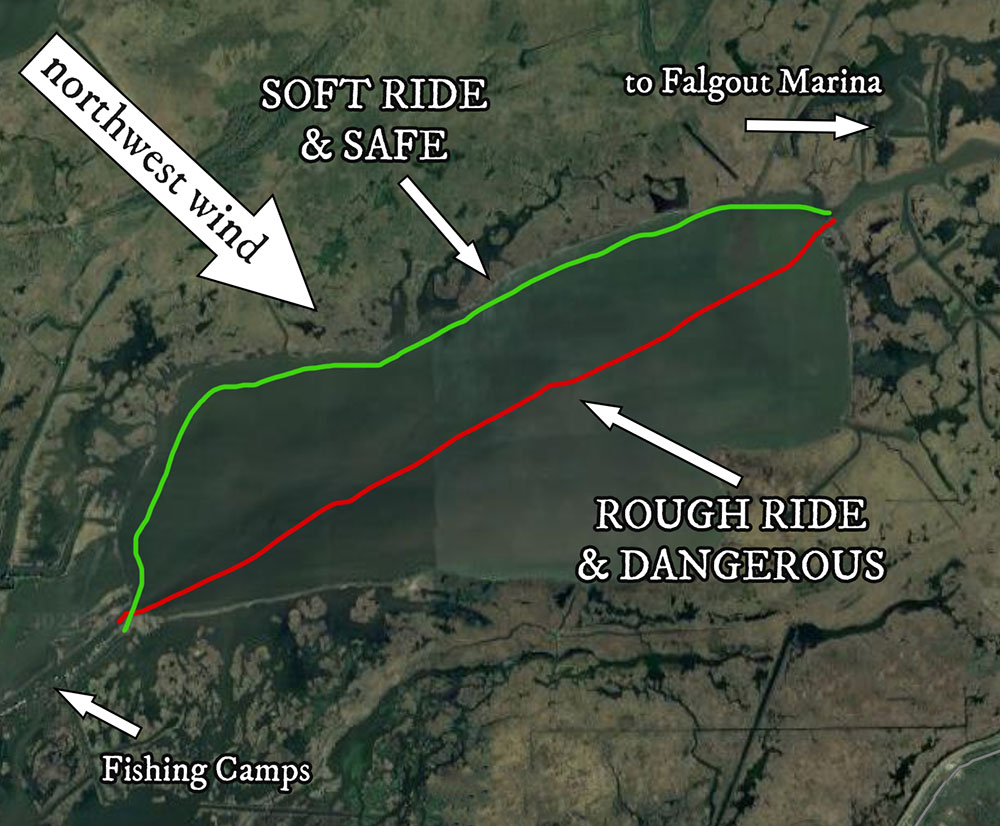
When To Start Looking
When planning a fishing trip I will being looking five to seven days out, anything beyond that is wishful thinking. and — even then — you must keep in mind that the weather will likely change. The closer you get to the day of your trip, the more accurate the forecast will be.
Understanding the seasonal pattern is key to tie this altogether. For example, during fall and winter the weather is dominated by cold fronts. The way these affect the wind is radically different from what we see during the summer (which is mostly low pressure and pop-up thunderstorms).
Having a holistic understanding of the current season and how to fish it is key, and that's why I've created four seasonal courses for catching speckled trout and redfish throughout the year.
Anyway, I've used Windfinder since 2015 to plan fishing trips across Louisiana's coast as well as Mississippi, Florida, and bass fishing the Tennessee River and other locations.
Additional Notes on Windfinder
Everything covered so far is the bulk of my feelings on Windfinder and how it applies to inshore fishing. But, there are a few more things you should know before running off and enjoying your fishing trip:
Differences Between Desktop Version and App
The desktop and app versions both look and behave the same, so there really isn't any significant difference between the two, other than one is optimized for a desktop and the other is optimized for a smartphone. They're both streamlined and intuitive.
What about Super Forecast?
I don't use it.
That's because it seems safe to assume that there's a margin of error within predicting something nobody knows for sure will happen until after it's happened.
After all, the weather forecaster's job is one he doesn't get fired from when he is (inevitably) wrong.
So, Super Forecast is a cool feature but I don't think it's necessary or superior to the 3-hour forecast.
Do you use it? If so, comment below and let us know what you think.
Is Windfinder ever wrong?
Of course, it's a forecast. Every forecast is eventually wrong. Don't be naïve.
What Windfinder Doesn't Do
It doesn't report every condition out there, even for weather stations it is pulling wind information from.
For example, Windfinder gets info from Bay Gardene and that station reports salinity, but I don't see this anywhere on their Bay Gardene page.
So, if you want to see the salinity trend for Bay Gardene, you must visit the USGS page for that station.
After that, there's also no daily satellite imagery like what's described in this blog post. Again, I keep this bookmarked so I can go straight to it when needed.
Furthermore, water levels are not provided, not for the marsh or rivers. I go to NOAA for that.
Lastly, fishing reports are nowhere to be found on Windfinder. That's not a fair assessment, as fishing reports really aren't a fishing condition per se, but they sure do help to know what's going on.
For the latest fishing reports I recommend LAFB Elite's Community.
Conclusion
Ultimately, Windfinder is another tool for us inshore anglers to use. But, it's a good tool that stands out amongst the rest. Like any good tool it must be used to its strengths. You wouldn't use a screwdriver to hammer a nail, right?
For your desktop computer I suggest bookmarking its home page centered over the area you primarily fish — like what I personally use here — and, in addition to that, bookmarking the individual weather stations most important to you.
Then, for your phone, add those same stations as "favorites" for easy reference.
What do you think?
I'm interested to know your thoughts, especially if they can add to the value of this guide, or create discussion that does the same.
- Do you use Windfinder?
- If not, what do you use to predict the wind?
Thanks for reading, and tight lines!

Yeah, I also cross-check it with the NOAA Marine Forecast, it’s just nice to see consistency. If there isn’t any, then something may be up. Thanks for commenting!
Hey Leo, thanks for commenting!
I use Windfinder to plan my fishing trips . Thanks to you Captain Devin. Now I must complete all the fishing courses and put them to use. Thank you Captain Devin for thoroughly explaining what, when and how to have a successful and safe trip.
I have been using Windfinder for many years and find it to be very good. I also look at NOAA as a back up plus Underground weather that is very good.
I am using Windy.App on iOS, looks similar to Windfinder – it provides wind speed, gust and direction at one-hour intervals for any location, with swell size and direction, tide and currents, air and sea temperature – other basic weather data (clear vs cloudy, precipitation forecast, etc.). I’m in Eden Isles, with the boat at a dock behind my house, so trailering isn’t usually an easy or practical option. This means crossing eastern Lake Pontchartrain, the Rigolets, and Lake Borgne for a trip to the Biloxi Marsh, so weather data is critical when planning these adventures in my small coastal skiff…
I live near the MS coast and have a 17’ Whaler. I use windfinder before I even consider the run out to the Biloxi marsh. I have relied on the Superforecast which often shows lighter wind predictions, but I believe your advice is correct. The regular forecast is often more reliable. Thanks for this presentation!
Hey Peter, I appreciate you taking the time to ask, but I think you really ought to read fishing reports inside LAFB Inshore. Your answer is definitely in there.
https://www.lafishblog.com/louisiana-fishing-reports/
Tight lines.
Devin, is there a speckled trout bite in Lake Pontchartrain right now?
Thanks Connor, that’s what I’m trying to get done here!
you know there really is no other website on the internet that i have found to this good thanks for contributing you time and resources to help people like me catch fish.